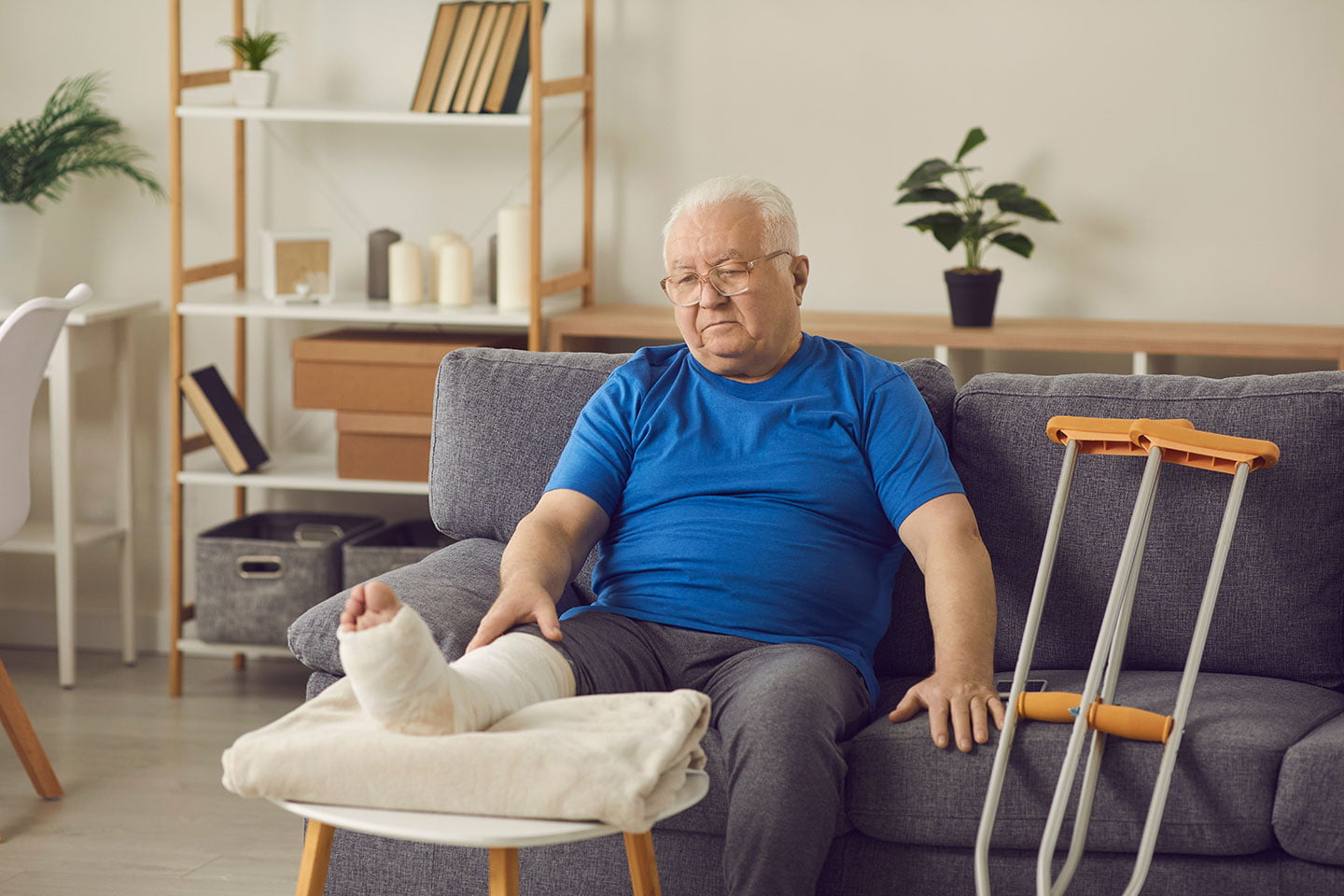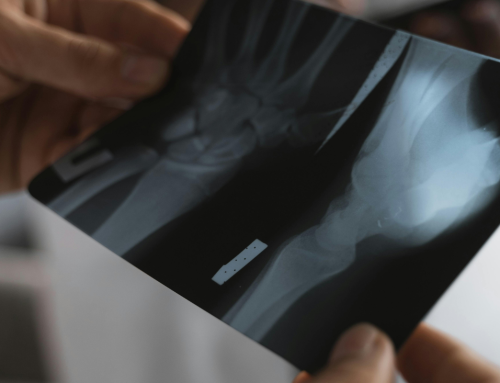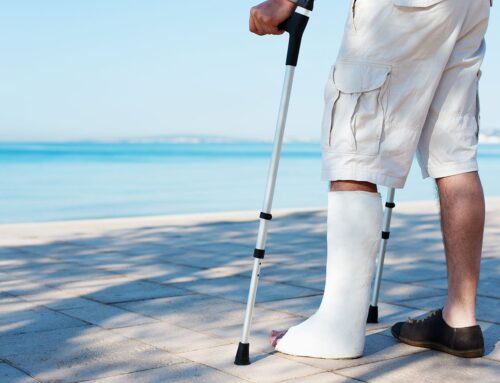Take control of your recovery—don’t just wait it out. If you’re frustrated by slow healing or worried about setbacks, this guide shows you exactly how to accelerate your bone fracture recovery safely and effectively.
In this guide, you’ll discover:
- Why your fracture is taking so long and what’s happening beneath your cast.
- Realistic timelines based on fracture type and several other factors.
- Proven nutrition and lifestyle strategies that can cut significant time off your recovery.
- The hidden factors that sabotage healing (and how to eliminate them).
- LIPUS therapy: An FDA-approved, non-invasive technology clinically proven to speed bone healing by up to 38%.
- Answers to your most urgent questions about healing faster.
- A detailed action plan based on your stage of recovery.

Bottom Line: While healing typically takes 4-8 weeks for simple breaks and 3-6 months for complex injuries, proper nutrition, lifestyle choices, and advanced therapies like LIPUS can significantly reduce your recovery time—especially for high-risk patients.
Fracture Healing: Why Recovery Takes So Long
Before we dive into solutions, it’s important to understand what’s happening inside your body right now. Bone fracture healing isn't a simple process—it's a complex biological cascade that occurs in multiple distinct stages.
The 5 Stages of Fracture Healing
Stage 1: Blood Clot Formation (Days 1-7)
Your body immediately forms a protective blood clot (hematoma) at the fracture site. This creates the foundation for everything that follows.
Stage 2: Soft Callus Formation (Weeks 1-3)
Your body forms a soft, cartilage-like bridge between the broken bone fragments, providing the first real stability.
Stage 3: Hard Callus Formation (Weeks 3-8)
Minerals like calcium are deposited into the soft callus, transforming it into actual bone. This is typically the longest active healing stage.
Stage 4: Bone Strengthening (Months 2-6)
The new bone continues to harden and solidify, allowing a gradual return to normal activities.
Stage 5: Bone Remodeling (Months 6-24)
The newly formed bone is slowly reshaped and strengthened to return to its original form and full strength.
Want to understand each stage in detail? Read our complete guide to the 5 stages of fracture healing.
The reality: Each fracture healing stage has critical windows where intervention makes the biggest difference. Miss these windows, and you're adding weeks to your timeline.
How Long Does a Fracture Take to Heal?
The frustrating answer: it depends. But here are realistic timelines based on fracture type and your individual circumstances:
Simple Fractures:
- Wrist (radius/ulna): 4-6 weeks
- Clavicle (collarbone): 6-8 weeks
- Fingers/toes: 3-4 weeks
Complex Fractures:
- Femur (thighbone): 4-6 months
- Tibia (shinbone): 4-6 months
- Ankle: 6-12 weeks
High-Risk Fractures (poor blood supply):
- Scaphoid (wrist): 8-12 weeks or longer
- Femoral neck (hip): 3-6 months
- Talus (ankle): 8-16 weeks
What Affects Your Fracture Healing Timeline?
Factors that speed healing:
- Youth (children heal significantly faster than adults)
- Good blood supply to the fracture site
- Proper immobilization and compliance
- Optimal nutrition
- Non-smoker status
Factors that slow healing:
- Smoking (can double your healing time)
- Diabetes or poor circulation
- Age over 50
- Poor nutrition
- Certain medications (steroids, NSAIDs)
- Inadequate immobilization
Critical Insight: Up to 10% of fractures experience significant delays or non-union. For high-risk patients (smokers, diabetics, complex fractures), this rate climbs to 20%. Early intervention is everything. (Source)
Proven Ways to Speed Up Bone Fracture Healing
Waiting passively for your fracture to heal is a choice—but it's not your only option. Here's your action plan for faster recovery:
1. Optimize Your Nutrition for Bone Repair
Your body can't build what it doesn't have. Bone healing demands massive amounts of specific nutrients. The essential four:
Calcium (1,200-1,500 mg daily)
- The primary building block of bone
- Best sources: Dairy products, leafy greens, sardines, fortified foods
- Food sources are superior to supplements for absorption
Vitamin D (1,000-2,000 IU daily)
- Essential for calcium absorption
- Get tested—most people are deficient
- Sources: Sunlight (15-20 minutes daily), fatty fish, fortified milk
Protein (1.5 g per kg of body weight)
- Provides amino acids for collagen formation
- Critical for soft callus development in weeks 1-3
- Sources: Lean meats, fish, eggs, legumes, dairy
Vitamin C (90 mg+ daily)
- Required for collagen synthesis
- Supports blood vessel formation
- Sources: Citrus fruits, berries, bell peppers, broccoli
Not sure what to eat? Get our complete guide to the best foods for fracture healing.
2. Eliminate Slow-Healing Culprits
These factors can add weeks or months to your recovery—or cause healing to fail entirely:
Quit Smoking
- Nicotine constricts blood vessels, starving your fracture of oxygen and nutrients
- Increases non-union risk by up to 4x
- Even quitting mid-recovery improves outcomes dramatically
Limit Alcohol
- Interferes with bone cell formation
- Impairs nutrient absorption
- Keep consumption to 1-2 drinks per week maximum during active healing
Avoid Routine NSAID Use
- High-dose NSAIDs (ibuprofen, naproxen) can interfere with bone formation, especially in the first 6 weeks
- Use only as prescribed by your doctor
- Acetaminophen is a safer alternative for pain management
Follow Immobilization Protocols
- Every time you violate weight-bearing restrictions, you risk disrupting the delicate healing process
- Non-compliance is the #1 predictor of delayed healing
- If you're struggling, talk to your doctor about modifications
3. Prioritize Sleep and Stress Management
Get 7-9 Hours Nightly
- Growth hormone peaks during deep sleep
- Your body dedicates maximum resources to repair during rest
- Poor sleep can extend your recovery timeline
Manage Stress
- Chronic stress elevates cortisol, which interferes with bone formation
- Practice relaxation techniques, gentle movement (when cleared), or meditation
4. Consider Proven Accelerators
Once you've mastered the fundamentals, advanced therapies can give you a significant edge—especially if you're high-risk or dealing with a complex fracture.
Physical Therapy (When Cleared)
- Essential for regaining strength, mobility, and function
- Prevents complications like stiffness and muscle atrophy
- Not optional for optimal outcomes
LIPUS Therapy
- An FDA-approved technology clinically proven to accelerate bone healing
- Reduces healing time by up to 38%
- Particularly valuable for delayed unions and high-risk patients
Learn how LIPUS can speed your fracture healing.
LIPUS Therapy: The Science-Backed Solution for Faster Healing
Low-Intensity Pulsed Ultrasound (LIPUS) isn't just another gadget—it's the most researched and validated bone healing technology available.
How LIPUS Works
LIPUS delivers precise, painless sound waves to your fracture site. These mechanical signals stimulate your bone cells to:
- Produce more healing factors
- Accelerate mineralization during the critical hard callus phase
- Increase blood flow to the fracture site
- Speed the entire healing cascade
The result: Your body heals faster—not through drugs or surgery, but by enhancing your natural repair mechanisms.
The Clinical Evidence
- 38% faster healing for fresh fractures compared to standard care
- 86% success rate for non-union fractures (fractures that stopped healing)
- Backed by 20+ years of clinical research and FDA approval
- Zero known side effects in over 1.5 million treatments worldwide
Using LIPUS is Simple
- Just 20 minutes daily
- Use at home—no clinic visits required
- Completely painless
- Works through casts and bandages
- One-button operation
Who Benefits the Most from LIPUS?
High-Risk Patients:
- Smokers (current or former)
- Diabetics
- Patients over 50
- Those taking medications that slow healing (steroids, immunosuppressants)
- Previous fracture complications
Time-Sensitive Recovery:
- Athletes needing rapid return to sport
- Workers who can't afford extended disability
- Anyone wanting to minimize downtime
Problem Fractures:
- Delayed unions (healing slower than expected)
- Non-unions (healing has stopped)
- Complex or high-energy fractures
- Fractures in poor blood supply areas (scaphoid, femoral neck, talus)
The Melmak LIPUS Advantage: FDA-approved, clinically proven, and designed for easy home use. With over 20 years of proven results, Melmak LIPUS is trusted by orthopedic surgeons worldwide.
Ready to accelerate your recovery? Contact us to learn more about the Melmak device.
FAQs: How to Heal a Bone Fracture Faster
How to heal a bone fracture faster?
The most effective approach combines three elements:
- Optimize fundamentals: Proper nutrition (especially protein, calcium, and vitamin D), quit smoking, and follow immobilization protocols.
- Eliminate saboteurs: Avoid NSAIDs, limit alcohol, and get adequate sleep.
- Add proven accelerators: Consider LIPUS therapy, especially if you're high-risk or experiencing delays.
The earlier you implement these strategies, the bigger the impact on your timeline.
What’s the best treatment to speed up bone fracture recovery?
LIPUS therapy is a non-invasive technology with FDA approval and Level 1 clinical evidence for accelerating fracture healing. Studies consistently show 38% faster healing times for fresh fractures and 86% success rates for non-unions.
Is LIPUS therapy safe?
Yes. LIPUS has been used safely for over 20 years with no known side effects. It's FDA-approved and recommended by orthopedic surgeons worldwide. However, you should always discuss any treatment with your doctor to ensure it's appropriate for your medical history.
Can I use LIPUS at home, or do I need to go to a clinic?
The Melmak LIPUS device is available for personal home use. You can purchase a device directly or work with a healthcare provider who offers LIPUS therapy. Most patients prefer home use for the convenience of daily 20-minute treatments without clinic visits.
How soon should I start LIPUS therapy?
The earlier, the better. LIPUS is most effective when started during the active healing phases (weeks 1-8). However, it can still benefit delayed unions and even non-unions that have stopped healing entirely. Talk to your doctor about starting as soon as your fracture is diagnosed.
Take Control of Your Recovery Timeline
Where you are in your recovery determines your best next move:
If You Just Got Injured (Week 1)
Priority: Set the foundation
- Schedule vitamin D testing with your doctor
- Stock your kitchen with high-protein, calcium-rich foods
- If you smoke, start your quit plan today
- Ask your doctor about starting LIPUS therapy early for optimal results
If You're in Active Healing (Weeks 2-8)
Priority: Optimize and monitor
- Ensure you're hitting nutrition targets daily (track for 3 days to verify)
- Watch for warning signs: increasing pain, no improvement by week 3-4
- If you're high-risk (smoker, diabetic, over 50), don't wait for delays—ask about LIPUS now
If Your Healing Seems Slow (Week 8+)
Priority: Intervene before it becomes non-union
- Request updated X-rays to assess progress
- Review all medications with your doctor (some slow healing)
- LIPUS shows strongest results for delayed unions—this is your window
- Consider consultation with an orthopedic specialist if no progress
If You're Cleared for Activity (Month 3+)
Priority: Rebuild without re-injury
- Start physical therapy if you haven't already
- Gradually increase loading—don't rush
- Continue nutrition support through the full remodeling phase
- LIPUS can still support final strengthening and healing
Don't Let Your Fracture Control Your Life
Every day counts when you're dealing with a fracture. The difference between a standard recovery and an accelerated one isn't just time—it's your quality of life, your independence, and your ability to work and move freely.
You've already taken the first step by researching how to heal faster. Now take the next one.
The science is clear: proper nutrition, smart lifestyle choices, and proven technologies like LIPUS therapy can significantly reduce your recovery time. For high-risk patients, these interventions aren't just helpful—they're essential for preventing serious complications.
Your fracture is healing right now. Are you giving yourself every advantage to heal as fast and completely as possible?
The Melmak LIPUS device has helped hundreds of thousands of patients recover faster from fractures. If you're tired of waiting and ready to take control of your recovery timeline, we're here to help.





